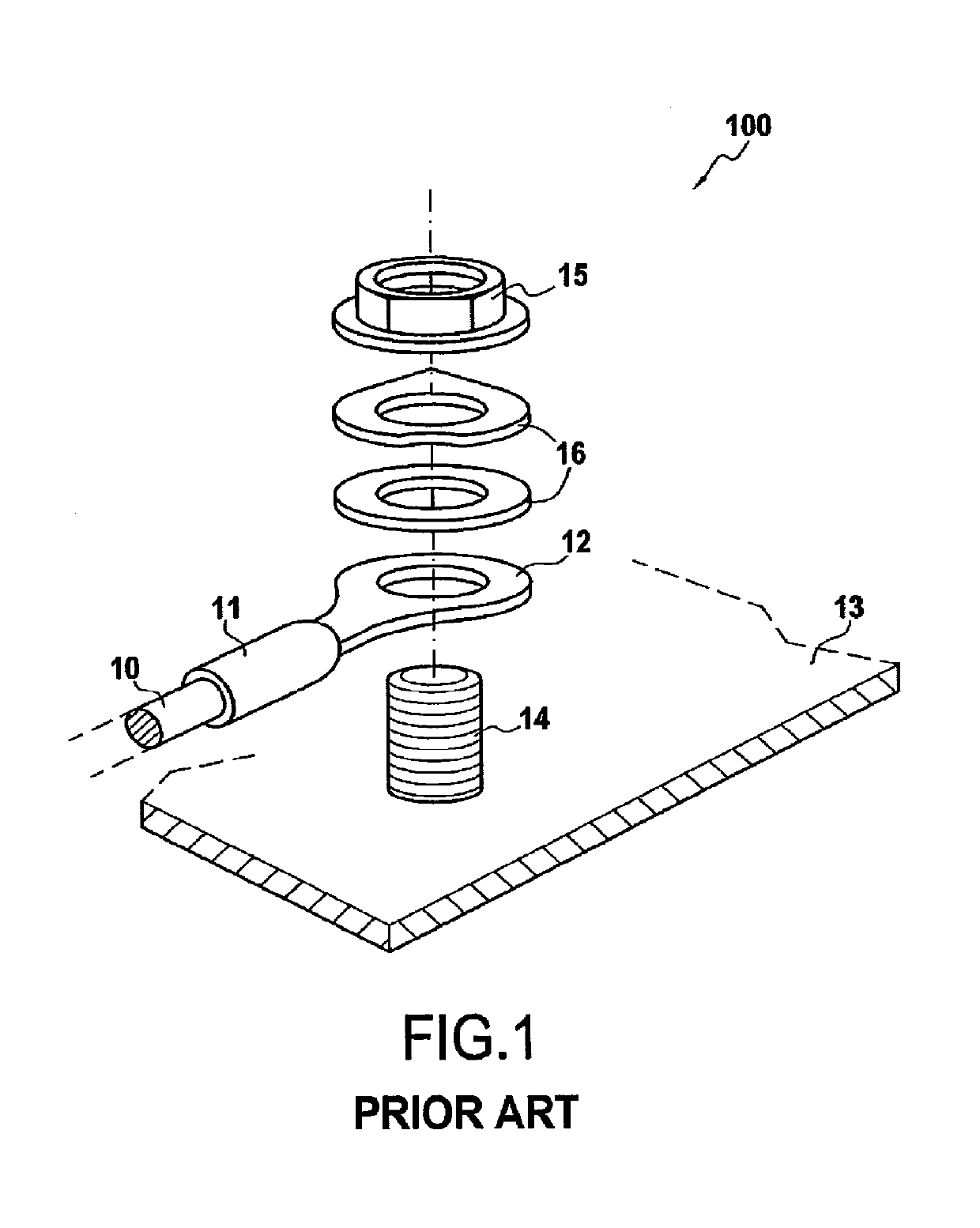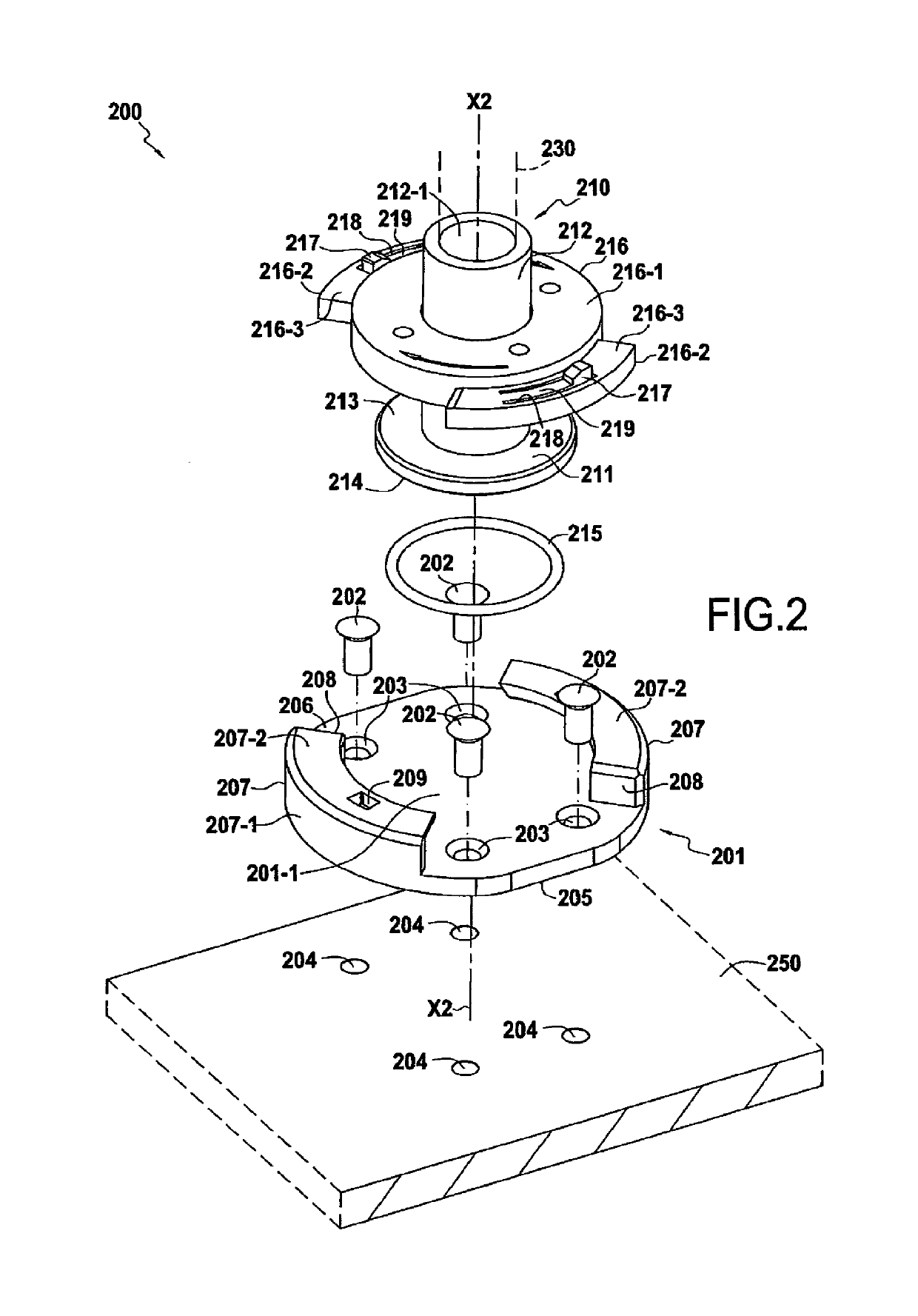Electrical connection device in an aircraft
a technology of electrical connection and aircraft, which is applied in the direction of electrically conductive connections, coupling device connections, vehicle connectors, etc., can solve the problems of low electrical conductivity, poor withstanding heating, carbon and/or composite materials that now replace metal structures, etc., to reduce the number of assembly elements, facilitate the making of electrical connections, and reduce the time
- Summary
- Abstract
- Description
- Claims
- Application Information
AI Technical Summary
Benefits of technology
Problems solved by technology
Method used
Image
Examples
first embodiment
[0046]FIGS. 2 to 5 show an electrical connection device 200 in the invention. In the example shown, the device 200 is centered relative to an axis of revolution X2 that is formed by a support 201 and by a terminal lug 210.
[0047]The support 201 is to be fastened to an electrically conductive structure 250, e.g. a metal structure of an aircraft. All or part of the support 201 is electrically conductive, in particular a bottom face of the support 201 that is to be fastened to the electrically conductive structure 250. The support 201 is fastened to the structure 250 by using permanent fastener elements 202, e.g. using rivets with countersunk or round heads, and passing in succession through fastener orifices 203, 204 formed respectively in the support 201 and the electrically conductive structure 250.
[0048]Below the term “bottom” is used to designate any face facing towards the structure 250, and the term “top” is used to designate any face facing away from the structure 250.
[0049]The ...
second embodiment
[0065]FIGS. 6 to 8 show an electrical connection device 300 in the invention. In the example shown, the device 300 is centered relative to an axis of revolution X3 and it is formed by a support 301 and a terminal lug 310, the support 301 being for fastening to an electrically conductive structure 350, e.g. a metal surface of an aircraft.
[0066]Below, the term “bottom” is used to designate any face facing towards the structure 350, and the term “top” is used to designate any face facing away from the structure 350.
[0067]The support 301 has a first face 302 (bottom face) that is to come into contact with the structure 350, and a second face 303 opposite from the first face 302, i.e. a top face. At least two locking clips 304 project from the second face 303 of the support 301 and define between them a housing 305 for receiving a bottom face of the terminal lug 310. In the example shown, the locking clips 304 are arranged in three sets 306 of three clips each. The sets 306 being regular...
third embodiment
[0080]FIGS. 9 and 10 show an electrical connection device 400 in the invention. The device 400 is constituted by a support 401 and a terminal lug 410, the support 401 being for fastening on an electrically conductive structure 450, e.g. a metal surface of an aircraft.
[0081]Below the term “bottom” is used to designate any face facing towards the structure 450, and the term “top” is used to designate any face facing away from the structure 450.
[0082]The support 401 has a first face 402 (bottom face) that is to come into contact with the structure 450, and a second face 403 opposite from the first face 402, i.e. a top face. An elastically deformable shoe 404 and at least one elastically deformable locking tongue 405 project from the second face 403, defining between them a housing 406, and they extend towards the inside of the housing 406. In the example shown, the support 401 has two locking tongues 405 projecting from the top face of the support 401.
[0083]The support 401 also has fas...
PUM
 Login to View More
Login to View More Abstract
Description
Claims
Application Information
 Login to View More
Login to View More - R&D
- Intellectual Property
- Life Sciences
- Materials
- Tech Scout
- Unparalleled Data Quality
- Higher Quality Content
- 60% Fewer Hallucinations
Browse by: Latest US Patents, China's latest patents, Technical Efficacy Thesaurus, Application Domain, Technology Topic, Popular Technical Reports.
© 2025 PatSnap. All rights reserved.Legal|Privacy policy|Modern Slavery Act Transparency Statement|Sitemap|About US| Contact US: help@patsnap.com



